
MISE Natsunosuke Solo Exhibition “Diverse Gods”
April 27 ~ June 23, 2014
air2013-1en
MISE Natsunosuke
三瀬夏之介
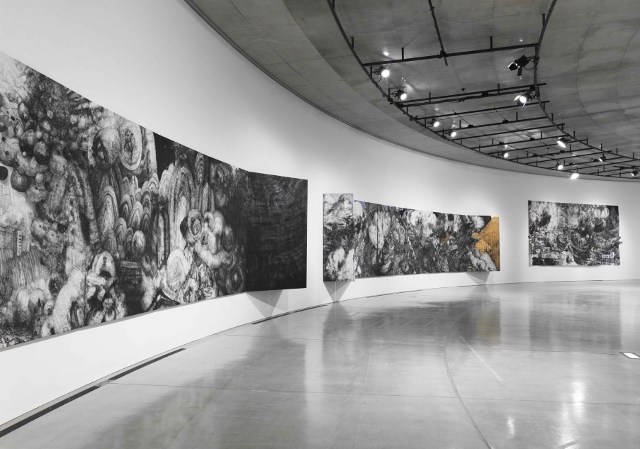
installation view photo: YAMAMOTO Tadasu
Painting of Japan by MISE Natsunosuke
KONDO Yuki
While producing works using what we call materials of ‘Japanese painting’ such as mineral pigments and washi (traditional Japanese paper), MISE Natsunosuke questions continuously how the way of painting called ‘Japanese-style painting’ should be, and thus he refers to ‘Japan’ itself in his creative activities. In Mise’s works, motifs that are modern, topical and/or familiar to him are used, which make his works appear to be a visual diary of the artist. Also included are motifs symbolizing Japan stereotypically such as a great image of Buddha and the Rising Sun flag, and also Adamski’s UFO and Nessie whose tricks have already been revealed, and subcultural motifs derived from manga characters. Being linked together prolifically, they build up a great image with immanent contemporariness. It must be true that he grasps them as reality, but when motifs and materials which remind us of history are added and integrated into the subject matter of ‘Japan,’ they are expressed as a horizontal axis depicting our contemporary age rather than ‘my’ personal feelings at ‘this specific time and place.’ And they are accumulated along the vertical axis of history.
Having graduated from the Department of Japanese Painting, he is naturally interested in materials and motifs of ‘Japanese-style painting’ as well as its system and historical development, and so, he has often mentioned them in various contexts. His interest is not limited to them, however. The subject of ‘Japan’ in his work often seems to be used as an intermediary to connect themes of artists, who have an awareness of contemporary issues, to the old layers of history. That has become more apparent in this exhibition and his new pieces produced for the exhibition.
As he frequently dismantles, revises and reintegrates his works in the past to create new pieces, it is difficult to define standards of his ‘new works.’ It would be safe, however, to say that Painting of Japan─the small basin universe is his new piece. Fields below mountains, huts and man-made sculptures such as ancient tombs similar to natural objects, and a range of mountains behind them are depicted in detail with ink and whiting on washi. The mountains are composed of those painted mountains and small pieces of torn paper forming a circle in the center of the picture. Those small hilly fragments are weakly connected one another as if they were joining hands, so that the whole work is made up with a sparse space in the center. Mise mentioned that when he tried to represent a sort of self-portrait of Japan in this work, there was an image of the national flag of Japan on his mind.(1) When you turn to the back of the work, you will find it covered with gold leaf. Small mountains on the surface with a variety of identities are replaced by a single color. The motif also overlaps with this country’s co-fantasy. The surface seemingly gold at first glance has deteriorated here and there and become darkened with rust. This indicates his implied judgment of the situation of Japan and structure of society.
'The small basin universe’ in the title comes from Shobonchi-uchu to Nihon Bunka (Small Basin Universe and Japanese Culture) written by cultural anthropologist YONEYAMA Toshinao who questioned the unity of Japanese society/culture and clarified the regional diversity of Japanese culture.(2) This thesis aims for, so to speak, local reinstatement, focusing on regional diversity of Japanese culture, dispelling the notion of myth fixed in modern times that Japanese culture is unitary, and envisaging the construction of local cultures open to the world. Mise’s work quoting the title from this thesis(3) that is oriented to restoration of provincial regions clearly shows not only his thoughts on ‘Japanese culture’ but also his interest in the potential of contemporary art(4) explored through his folkloric approach. His interest in the pre-modern folkloric elements were indicated in his works before, but it was probably after 2009 when he assumed a new post at Tohoku University of Art and Design in Yamagata that his coming in contact with the customs of the Tohoku region from a folkloric perspective had not a little impact on his interest. He has adopted ‘Painting of Japan’ instead of ‘Japanese Painting’ as the translation of Nippon no E for the first time in this exhibition. It is probably because his works are not traditional Japanese paintings but they are paintings depicting ‘Japan’ diachronically as well as synchronically.
In the venue where Painting of Japan─The small basin universe is on display, several pieces of small mountain-like fragments, which are parts of the work, are shown in glass showcases with respective names. (fig.1) Being displayed along with Painting of Japan─The small basin universe, they showcased the ‘individuality’ of each mountain aggregated into a single flag, adding another meaning to the work. Thus, in his works, the form, materials and the nature of the substance are often deeply involved with the meaning and content of the work.
In Painting of Japan─The small basin universe, eyelets are made directly in the work to suspend the painting in the center of the gallery, so that the form itself becomes ‘a flag which appears to be streaming in the wind’ and ‘a flag that is crumbling,’(5) or by being put up as a national flag floating in the air like a fictitious symbol, it reminds us of a risky relationship between painted mountains (=regions and people) and the flag as a whole (=nation). Viewers can go around to the back of the work. Doing so, they find that the large landscape painting with a sparse space in the center reveals the texture of flimsy paper. Not only the material itself is eloquent but also the texture of the material spoils the fiction of ‘image’ created by the painting.
As for Painting of Japan─Laughing Moon, there are his sketches, pieces of old paper and pencils pasted on it, gaps in seams and twisted-paper strings used partly on the picture. (fig.2, 3) Viewers, who are touring the world of the painting enjoying looking at details as they approach a huge image of billowing smoke, which reminds them of eruption and explosion, are suddenly pulled back into the three-dimensional world. If Mise, because of his distrust of images(6) brings in fragments of reality and three-dimensional objects, he seems to be trying to follow the style of collage and papier colle, which introduced reality onto the ‘sacred’ painting. On the other hand, however, the picture layout bringing out the best expression of the material reminds us of the way of making up the image on the picture without losing much of the natural texture of the material, just like gold leaf and mother-of-pearl inlay found in Japanese traditional crafts and paintings.
On the other hand, Trying to Change This Moment into Eternity (fig.4) and open fifth (fig.5) are paintings, each of which makes us feel the volume of materials in itself in the space. In this exhibition, both ends of the work are lifted off the wall so that ‘sides’ of the picture are created. That has made it possible to introduce a part of the painting as a substantial mass in the space, and at the same time, in contrast to the flat part, they look like forming a frame while being a part of the painting. What is more, the two on display in the same format are symmetrical on the left and right, so that viewers perceive the wall space in the middle as a blank space created in the center between the two paintings. That reminds us of the relationship between the real space and space in a painting whose boundary is ambiguous as shown in Japanese antiques, such as a plane flat painting on the wall, sliding doors and folding screens put in the three-dimensional space, and calligraphic works on painted scrolls whose images are linked one another. Needless to mention Roland Barthes’s ‘empty center,’ this structure is repeatedly used as ‘Structure of Japan’(7) in similar vein of his pictorial structure using symmetrical images and a blank in the center of Painting of Japan─The small basin universe and Divers Gods (2013)(8), his new work that was not exhibited at ACAC this time. Thus, it can be said that his aesthetic liking in the old layers of history and association with history are not only perceptible in the materials and motifs.
Mise quotes real affairs onto his painting and depicts various deplorable situations of Japan using images that strongly impress us as collapse, distortion and chaos. Even if he expresses them in a manner in which physical fragility is emphasized as in Painting of Japan─The small basin universe, the work still keeps the strength of an inviolable image floating in the air. This only indicates that he is presenting, through his painting, something that has overcome chaos and collapse or something that will replace what we have lost. That leads to the exhibition title Divers Gods, but it does not necessarily mean the religious God. It is used as a symbol of an idea, ideal or something like vision─even if it is a fantasy. I think that, simply because he owes it to his painting, he does not use a single clear form but uses vague images like something like a flag, God, mountain and fumes, which are big and give us an overwhelming impression being able to reflect stories on viewers’ minds. For this exhibition, he wanted to position the overall display slightly higher than usual. It indicates that he believes in the power of art as a symbol, not as mere decoration or an object of pleasure, and intends to revive the role of art in the society, although he uses familiar motifs and his pictorial images have close affinity with space and substances in real life. Here, I can see how the artist strongly desires, in order to live in this unstable world, for the advent of something that goes beyond paintings based on personal feelings and judgment, without giving up his own sense of body and subjectivity.
(1) Interview with Mise, AC2, No. 15, July 1, 2013. (Aomori Contemporary Art Centre, Aomori Public University)
(2)YONEYAMA Toshinao, Shobonchi-uchu to Nippon Bunka, (Iwanami Shoten, 1989).
(3) Surrounded by mountains and separated by the watershed, a town in a basin is where people, things and information gather. Relatively it forms a closed community and is likely to have its unique history and cultural tradition. Based on such a geographical feature, a unique spiritual world constructed by local residents is called ‘small basin universe.’
(4) According to his comment in the closing talk ‘What is Tohoku Painting?’ as well as in the dialogue with KUSANAGI Natsuko, director of the Hiratsuka Museum of Art, MISE Natsunosuke x KUSANAGI Natsuko, “Dialogue for Painting of Japan’,” in Mise Natsunosuke: Painting of Japan, Seigen-sha, 2013, pp. 101-103.
(5) Ibid. footnote 1.
(6) His comment at the opening artist talk, April 27, 2013.
(7) The dialogue with KUSANAGI Natsuko, director of the Hiratsuka Museum of Art, MISE Natsunosuke x KUSANAGI Natsuko, “Dialogue for Painting of Japan’,” in Mise Natsunosuke: Painting of Japan, Seigen-sha, 2013, pp. 101-103.
(8) The work was created at Aomori Contemporary Art Centre, but it was shown at his solo exhibition Painting of Japan, held at the Hiratsuka Museum of Art, July 13 through September 16, 2013.
*************************
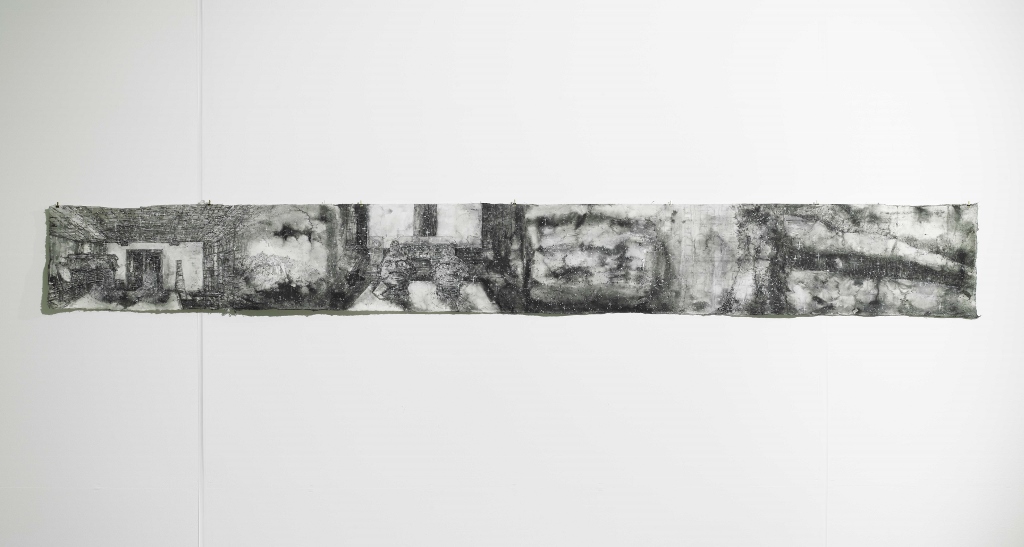 Yamagata⇔Aomori, 2013. photo: YAMAMOTO Tadasu
Yamagata⇔Aomori, 2013. photo: YAMAMOTO Tadasu
My first visit to the Aomori Contemporary Art Centre (ACAC) was in January 2013. Even after living in Yamagata Prefecture for four years, I felt Aomori had a marvelous amount of snowfall. I sought out an exhibition space similar to a kamakura, a rough equivalent to a Japanese igloo, as the location for my art.
The actual production of my work began in March, at a time when a particular resident of Aomori City was grappling with production in the studio. When we discussed the theme of her relationship between herself and Aomori’s famous apples, she laughed, “My prints are expressions of the love I have for my hometown.”
Amid the production cycle of drawing, eating, and sleeping, I was saved by the cheerfulness of the cleaning crew at the residence facility. One of the female crew, who also moonlights as a part-time inventor, took a look at one of my works in production and told me, “This is the universe.”
Aomori’s deep snows steadily gave way to spring after a repetition of blizzards and fair days, which resembled waves which continually lap against the shore only to retreat to the sea.
Once as I was finishing production on my work, I was struck by a modest sense of wonder. In my work, I had to take the utmost care to connect and graft fragments of Japanese paper together. Whether to match, disconnect, or layer the fragments, or to make the fragments collide?the relationships lie in the way the paper is overlaid, and their accumulation represent the present world itself.
As I continued to ponder these relationships, the fragments began connecting themselves right before my eyes one day during production. It felt as if a landscape of the world was taking form without any intervention on my part.
After much contemplation, I decided on a title for the exhibition: “Diverse Gods.” It was originally intended to question the existence of contemporary beliefs and their relation to art, but I learned soon after my arrival that individuals with occupations such as fortunetellers, shamans, and mediums all share the common title of kamisama, the Japanese word for god, in Aomori. At the northernmost tip of Honshu, I hit upon the idea that we may have lost something along the distorted path of modernization.
I was reminded of the obvious here in Aomori: that a work of art ultimately begins with the decision of an individual. You could also say that I was only able to resolve the dilemma of beauty and that unavoidable aspect of artistic vanity by creating value for my work beforehand.
It was the honest, hard-working people of Aomori who taught me this.
MISE Natsunosuke
photo: YAMAMOTO Tadasu
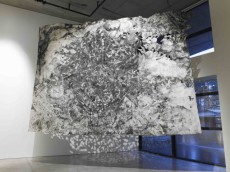
Painting of Japan─the small basin universe, 2013. photo:YAMAMOTO Tadasu

Painting of Japan─the small basin universe, 2013. photo:YAMAMOTO Tadasu

fig.1 Meditation, 2013. photo:YAMAMOTO Tadasu
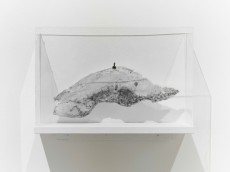
fig.1 Shut in snow, 2013. photo:YAMAMOTO Tadasu
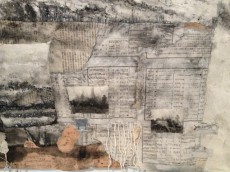
fig.2 Painting of Japan~Laughing Moon~(detail)

fig.3 Painting of Japan~Laughing Moon~(detail)
fig.4 Trying to Change This Moment into Eternity., 2010. photo: SENO Hiromi(FLOT)
fig.5 open fifth, 2012. photo: SENO Hiromi(FLOT)

Painting of Japan~Laughing Moon~, 2013. photo: SENO Hiromi(FLOT)
三瀬夏之介個展 ぼくの神様
2013年4月27日(土)~6月23日(日)
三瀬夏之介
MISE Natsunosuke

展覧会会場風景 撮影:山本糾
三瀬夏之介の日本の絵
近藤 由紀
三瀬夏之介は、岩絵の具や和紙といったいわゆる「日本画」的な素材を用いて作品を制作する一方で、「日本画」という絵画のあり方を問い続け、延いては「日本」それ自体に言及しながら作品を制作している。三瀬の作品には、しばしば作家の身近なモティーフや、現代的、時事的なモティーフが登場し、作家のヴィジュアル・ダイアリーのような様相を呈する。そこには大仏や日の丸といった日本をステレオタイプ的に象徴するモティーフやトリックであることが既に暴かれているアダムスキー型UFOやネッシー、あるいは漫画等のキャラクターといったサブカルチャーに由来するモティーフも多く含まれ、それらが増殖的に結合し、現在性を内在した大きなイメージを作り上げている。それらは作者がリアリティをもって把握しうる現実であるには違いないのだろうが、そこに歴史を感じさせるモティーフや素材が加わり、「日本」という題材でまとめられた時、それらのモティーフは、「今・ここ」にいる「私」のプライベートな感覚を表すというよりは、「私」と横並びに在る同時代を示す一つの横軸として示され、そこに至るまでの歴史的な縦軸の上に積み重ねられる。
日本画科を卒業している三瀬は、当然のことながら「日本画」の画材、画題、そのシステムや歴史的展開にも深い関心を抱き、様々な場面で言及している。しかしそれだけにとどまらず、三瀬作品における「日本」という題材は、しばしば同時代的な問題意識をもつ作家の主題を歴史の古層とつなぐための媒介として用いられているようにも思われる。そのことは、今回の展覧会と展覧会のために制作された新作においてより顕著に表された。
三瀬は、過去作品を解体、加筆、再統合することで新たな作品とすることも多いため、「新作」という基準がはっきりしにくいが、それでも《日本の絵~小宇宙盆地~》は、新作といっていいだろう。和紙に墨と胡粉で、裾野の田畑、古墳のような自然物にも似た人工の造形物や小屋、その背後に連なる山々などが、細かく描かれている。それらの山々は、描かれた山々と画面の中心に円を描くように連なる千切られた紙片によってできており、その小さな山のような断片は僅かな部分で弱々しく繋がりながら、中央に疎を抱えた一つの全体を作っている。日本の自画像のようなものを現そうとしたというこの作品の制作にあたり、三瀬の念頭には国旗である「日の丸」のイメージがあったという(*1)。作品の裏側に回るとそれは金箔で覆われ、表面の様々な個性を持った小さな山々が、単一の色彩に置き換わる。それはこの国の共同幻想とも重ねられているのだが、一見金一色にみえるその表面は、ところどころ劣化して錆びて黒ずんでいる。それらは三瀬の考える日本の状況や社会の構造を暗示する。
タイトルにある「小盆地宇宙」とは、日本社会/文化の単一性を疑い、日本文化の地域的多様性を明らかにした文化人類学者の米山俊直の著作『小盆地宇宙と日本文化』(*2)からの引用である。日本文化の地域的な多様性に着目し、近代が育てた日本文化の単一性という「神話」に対する認識を解体し、世界に開かれた地域文化の建設を構想する、いわば地方の復権を志向した論文(*3)のタイトルを引用したこの作品は、「日本文化」についての考察のみならず、三瀬の民俗学的なアプローチによる現代美術の可能性(*4)についての関心を端的に示している。前近代の土俗性に対する関心は、これまでの三瀬の作品にもみられるが、それでもそれは三瀬が2009年から山形県の東北芸術工科大学に着任し、東北の風俗に民俗学的アプローチから接触したという経験が少なからず影響を与えているのだろう。三瀬は今回からこれまでのJapanese Painting であった《日本の絵》の英訳を Painting of Japan とした。それはこれらの作品が、Japaneseすなわち日本人の、日本固有の絵ではなく、通時的かつ共時的に「日本」を描こうとした絵であるからであろう。
ところで《日本の絵~小宇宙盆地~》が展示された会場内には、作品を構成している小さな山のようなものの断片が数点、それぞれに名付けられ、ケースに収められて展示された(fig.1)。それは《日本の絵~小宇宙盆地~》と共に展示されることによって、単一の旗を作るために集約された一つ一つの山々の「個性」を示すショーケースとなり、作品にもう一つの意味を付与する。このようにしばしば三瀬の作品にはその形体や素材、物質としてのあり方が作品の意味内容と深くかかわっている。
《日本の絵~小宇宙盆地~》は、作品に直接鳩目が穿たれ、ギャラリーの中央に吊るされ、形体それ自体が「なびいているように見せかけている旗」、「崩壊しつつある国旗」(*5)、あるいは虚構のシンボルのように宙に浮く国旗のように置かれることで、描かれた山々(=地域や人々)と全体としての旗(=国家)の危うい関係を想起させる。鑑賞者は作品の裏側に回ることができるのだが、ぐるりと作品を回り込む時、中心に疎を抱えた大きな山水画は、一枚のペラペラとした紙の物質感を露わにする。それは素材そのものが雄弁であるだけではなく、物質としての素材感が絵画が作り出す「イメージ」の仮構性に肩透かしをくらわせる。
《日本の絵~笑月~》の画面には三瀬の小品や、古紙、鉛筆などが画面に貼り付けられていたり、繋ぎ目に隙間があったり、画面の部分が紙縒りになっていたりしている(fig.2, 3)。噴火や爆発を思わせる噴煙があがる巨大なイメージに近づき、詳細な部分を堪能しながら絵画内世界を周遊していた鑑賞者は、それによって唐突に三次元の世界に引き戻される。三瀬が「イメージに対する不信」(*6)から現実の断片や三次元的な事物を画面に取り込んだのだとすると、それは「神聖」な絵画面に現実を引きこんだコラージュやパピエ・コレの流れを汲む試みのようにみえる。しかし一方で、素材そのものの表情が生かされた画面構成は、日本の伝統工芸や絵画にみられるような、金箔や螺鈿といった素材それ自体の状態をさほど損なわず、生の素材感を残したまま画面上のイメージを構成する作り方を想起させる。
一方パネル貼りされた《だから僕はこの一瞬を永遠のものにしてみせる》(fig.4)や《空虚五度》(fig.5)は、作品それ自体が空間の中で物量を感じさせる絵画である。これらは今回画面の両端を壁面から立ちあげることで、絵の「側面」のようなものが作られた。それは絵の一部を空間に塊として存在させると同時に、平らな部分との比較において、そこは絵画の一部でありながらフレームのような存在ともなった。さらにこの二つは同じフォーマットで左右対称をとるように展示されることで、中央の壁面スペースが、二つの絵画の中央に生まれた空白として意識される。そのことは、三次元空間にはめ込まれた平面絵画である障屏画や、しばしば画面内のイメージと地続きともなる軸装された書画など、日本の古美術の、境界が曖昧な現実空間と絵画内空間の関係性を思い起こさせる。またこれは《日本の絵~小盆地宇宙~》における中央の「疎」や今回ACACでは展示されなかった新作《ぼくの神さま》(2013年)(*7)における左右対称の図像と中央の空白といった画面内構造と同様に、ロラン・バルトの「空虚の中心」を引き合いに出すまでもなく、「日本の構造」(*8)として、今回繰り返し用いられている構造でもある。こうしてみると、三瀬作品における古層の美意識や歴史との連関は、画材や画題からのみ示されるのではないといえるだろう。
一方で三瀬が現実の事物を画面に引用したり、日本の様々な危機的な状況を、崩壊や歪み、混沌を強く感じさせるイメージで描き、それを《日本の絵~小盆地宇宙~》のように物理的に脆弱さを強調した仕方で表現したとしても、やはりその作品はどこか中空に浮いた不可侵のイメージのような強さを保っている。それは三瀬が崩壊や混沌を乗り越えた先の何か、あるいは失ってしまったものの代わりになるような何かを絵画によって提示しようとしているからにほかならない。それが今回の「ぼくの神さま」という展覧会タイトルとつながっていくのだが、それは必ずしも宗教的な神さまを指してはいるのではなく、ある種の思想や理想、ヴィジョンのようなもの――たとえそれが幻想だとしても――の象徴として示されている。だがそれを絵に負うているからこそ、明確な一つの形をとることなく、旗や神のようなもの、山や噴煙のようなものといった、見る者の物語を投影しうる巨大で圧倒的な印象を与える漠然としたイメージが用いられているのだろう。三瀬は今回の展示で、作品の位置を全体的に少し高めに設定した。それは作品のモティーフが身近であり、絵画内イメージが現実の空間や物質と親和性があったとしても、存在的には日常的な装飾や慰み物としてではなく、ほかならぬ芸術の象徴としての力を信じ、その社会における役割を復活させようとする意思の表れであろう。そこには、この不安定な世の中を生きるために、自分の身体感覚や主観性を手放すことなく、それらを判断基準とする私的な感覚による絵画を越えるものを希求する作家の姿勢がみえる。
*1--2013年7月1日定期刊行誌『AC2』15号(青森公立大学国際芸術センター青森発行)のためのインタビューでの発言。
*2--米山俊直『小盆地宇宙と日本文化』、岩波書店、1989年。
*3--米山は、四方を山に囲まれ、分水嶺をもち、盆地底に人、もの、情報の集散する拠点としての町を持つ小盆地では、相対的にひとつの閉鎖的空間を作り、そのために独自の歴史や文化伝統を持ちやすいとし、こうした地形を特徴とする世界で、住民が構築してきたそれぞれに個性をもった精神世界を「小盆地宇宙」と呼んでいる。
*4--クロージングトーク「『東北画』とは何か?」の中での発言(2013年6月23日)、および2013年4月14日草薙奈津子氏(平塚市美術館館長)との対談での発言(三瀬夏之介×草薙奈津子(平塚市美術館館長)「『日本の絵』のための対談」、『三瀬夏之介 日本の絵』、青幻社、2013年、91-94頁に採録。)
*5--註1に同じ。
*6--2013年4月27日オープニングアーティスト・トーク時の発言。
*7--国際芸術センター青森にて制作されたが、同年7月13日-9月16日に開催された平塚市美術館での個展「日本の絵」において展示された。
*8--2013年4月14日草薙奈津子氏(平塚市美術館館長)との対談での発言(三瀬夏之介×草薙奈津子(平塚市美術館館長)「『日本の絵』のための対談」、『三瀬夏之介 日本の絵』、青幻社、2013年、91-94頁に採録。)
*************************
《山形⇔青森》2013年 撮影:山本糾
初めてACAC入りしたのは2013年の1月。山形に住み始めて4年目の僕にとってはちょっと驚異的な積雪量。まるでかまくらの中のような展示室に美術の所在を探した。
本格的な制作は3月に入ってからで、ちょうど青森市在住の方が版画室で作品と格闘していた。リンゴと自分の関係をテーマにしているという彼女は、「私の絵は郷土愛よ」と笑った。
描く、食べる、寝る、という生活が続く中、レジデンス施設を掃除してくれる方々の明るさには救われた。その中の発明家でもあるというおばちゃんは、制作途中の僕の絵を見て「これは宇宙」だと言ってくれた。
まだまだ雪深かったが、吹雪と穏やかな晴天を繰り返し、寄せては返す波のように外は春に向かっていった。
滞在制作も終盤に差し掛かったある時、アトリエで少し不思議な感覚に包まれた。和紙の断片による継ぎ接ぎで形作られている今回の作品は、その繋げ方に細心の注意を払わなければいけなかった。馴染ませるのか、繋げないのか、積層させるのか、衝突させるのか、その関係の集積が現在世界そのものの表現となる。
検討を重ねながら制作を進めていたある日、眼の前で勝手に断片が繋がり始め、僕の手を離れて世界の風景が立ち上がっていく、そんな感じがした。
個展タイトルはいろいろ悩んだ末、「ぼくの神さま」と決めた。現代における信仰心の在処と美術の関係を問うものだったが、後に青森には神さまと呼ばれる人がいることを知った。僕たちは歪な近代化の中で何かを失ってしまったのではないかと本州最北端の地で考えた。
絵はどこまでも個人の決断から始めなくてはならないという当たり前のことに、ここ青森で気付かされた。価値を事前に与えることによってしか独善を回避できない"美を巡る問題"にようやく踏ん切りがついたとも言える。
それはこの地で誠実に仕事をする人々に教えられた。
三瀬夏之介
撮影:山本糾

《日本の絵~小盆地宇宙》2013年 撮影:山本糾

《日本の絵~小盆地宇宙》2013年 撮影:山本糾

fig.1 《黙考》2013年 撮影:山本糾

fig.1 《雪ごもり》2013年 撮影:山本糾

fig.2 《日本の絵~笑月~》(部分)

fig.3 《日本の絵~笑月~》(部分)
fig.4 《だから僕はこの一瞬を永遠のものにしてみせる》2010年 撮影:瀬野広美(FLOT)
fig.5 《空虚五度》2012年 撮影:瀬野広美(FLOT)

《日本の絵~笑月~》2013年 撮影:瀬野広美(FLOT)

